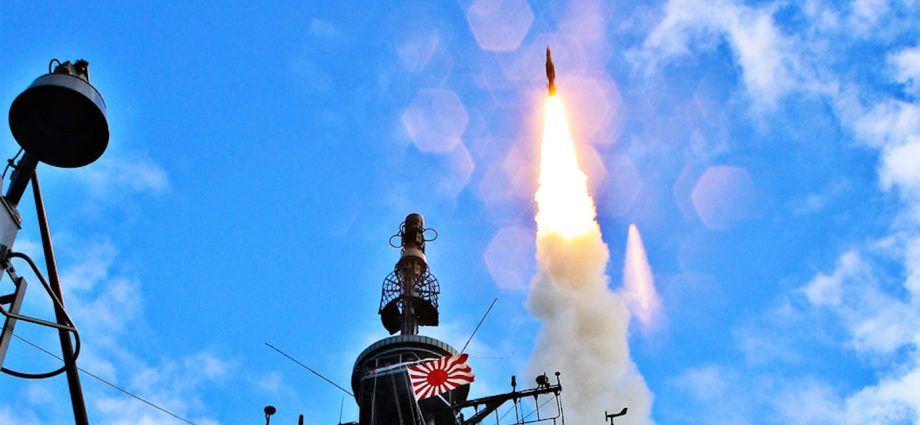Japan’s Ministry of Defense (MOD) has allocated substantial funding to build two massive Aegis System Equipped Vessels (ASEV), marking a pivotal shift from land-based systems to a more dynamic and versatile naval approach to countering ballistic missile threats from China and North Korea.
Naval News reported that the MOD has secured US$2.6 billion (373.1 billion yen) for fiscal year 2024 to build two ASEVs. The big-ticket budget allocation comes after Japan scrapped earlier plans to deploy a land-based Aegis Ashore ballistic missile defense system.
Naval News notes that Japan’s MOD plans to begin building the first ship in the next fiscal year and requested 379.7 billion yen in a defense budget request on August 31.
It says that the final budget for the ASEVs’ construction is almost the same as ordered. Naval News says that Defense Minister Minoru Kihara met with Finance Minister Shunichi Suzuki to discuss the matter on December 19.
Japan’s MOD has selected Lockheed Martin-made AN/SPY-7 solid-state radars (SSRs) for the two ASEVs over Raytheon’s AN/SPY-6 radar, which was initially designed for US Navy warships equipped with the Aegis Combat System.

The Japanese Maritime Self-Defense Force (JMSDF) is expected to take delivery of the first ASEV during fiscal year 2027, with the second one delivered in fiscal 2028, according to the Naval News report.
Naval News describes the ASEV as similar to two Maya-class ships with a Mk-45 (Mod.4) 5-inch/62-caliber (127 mm) main gun, SM-3 Block IIA and SM-6 missiles. The ASEVs are set to be upgradeable throughout their projected 40-year service lives.
In an August 2023 article for The Warzone, Thomas Newdick notes that the new ships will take on a more extensive counter-hypersonic weapons capability over time with the addition of new weaponry.
Newdick says the vessel will also include the latest and much more capable version of Type 12 anti-ship missiles now in development, giving them a kinetic capability beyond their anti-air/anti-ballistic missile role.
He notes that the ASEVs will have 128 vertical launch cells and a 240-strong crew and that from fiscal year 2032 the ASEVs will be armed with high-power laser weapons, primarily for use against hostile drones.
Newdick mentions that the ASEVs are meant to be a follow-on to the Maya-class, with their design making them multi-role conventional surface combatants and not just floating missile defense platforms.
He also draws comparisons between the ASEV and China’s Type 55 cruisers, saying that while the ASEV is more focused on missile defense, the Type 55 performs a broader range of missions such as operating as part of a carrier battlegroup or the flagship of a surface action group.
Japan’s 2023 Defense White Paper says that the ASEV will provide integrated air and missile defense capabilities in response to increasingly sophisticated airborne threats.
Akihisa Nagashima, in an August 2021 Konrad Adenauer-Stiftung (KAS) paper, mentions that given North Korea’s increasing missile threats, Japan needs a missile defense system that can defend against missile attacks 24 hours a day, 365 days a year.
Nagashima says that the ASEVs could free US and Japanese Aegis destroyers from ballistic missile defense (BMD) patrols in the Sea of Japan, increasing their availability for operations in southwestern Japan, particularly around the Ryukyu Islands.
That, in turn, would allow them to refocus on their primary missions of fleet air defense and anti-submarine warfare against Chinese incursions into the open waters of the Pacific Ocean via the Miyako Strait.
The ASEVs can also enhance the survivability of Japan’s missile defenses against a potential saturation attack from China or North Korea. Asia Times noted this month that China has enough munitions to hit 500 critical targets in Japan, with land-based missile defense-related infrastructure likely to be on any Chinese target list.
ASEVs could provide a mobile, survivable platform to maintain missile defense capabilities and cover the gaps in Japan’s land-based defenses. Aside from lasers, Japan’s ASEVs may be armed with railguns.
In October 2023, Asia Times reported that Japan had successfully tested a medium-caliber maritime electromagnetic railgun via an offshore platform, indicating the potential for shipborne deployment aboard ASEVs.
The test was conducted by Japan’s Acquisition Technology & Logistics Agency (ATLA) and the Japanese Maritime Self-Defense Force (JMSDF). The railgun uses electromagnetic energy to propel projectiles at extremely high velocities, potentially reaching hypersonic speeds.
Japan plans to deploy the weapon on land and at sea. The railgun can fire 40 mm steel projectiles weighing 320 grams each and will eventually run on 20 megajoules of charge energy.
Railguns have numerous advantages over missiles and could prove to be the most cost-effective defense against hypersonic threats. Railgun projectiles are comparatively more affordable per round, costing at most US$35,000 while an SM-3 missile round costs $30 million.
Moreover, railgun projectiles are devoid of explosives and eliminate targets solely through kinetic energy, unlike artillery shells and missiles. This feature reduces the burden on logistics and improves handling safety, allowing for storing additional ammunition on ships or in batteries located on land.

Railguns are also unaffected by weather and line-of-sight conditions, unlike laser weapons, which represent an alternative missile defense technology. Still, Japan’s ASEVs will hardly eliminate or neutralize China and North Korea’s evolving missile threats.
Still, Japan will find it challenging to maintain its ASEVs around the clock, compared to land-based missile defenses that can be held at constant readiness, and will likely face the same operational problems besetting its Aegis destroyer fleet regarding logistics, personnel and maintenance.
At the same time, Japan’s ASEVs will no doubt become priority targets for China’s DF-21D and DF-26 anti-ship ballistic missiles and North Korea’s extensive missile arsenal.

